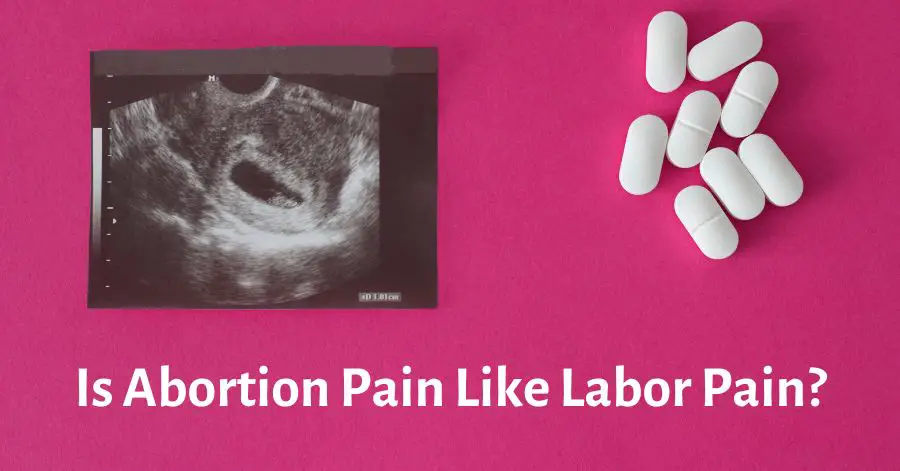Abortion and Labor are both painful life experiences. They affect our entire body, and mind and can have a long-lasting impact on our life. But which one is more painful?

Is Abortion Pain Like Labor Pain? – What are the Differences?
Abortion pain is not exactly like labor pain, as it generally feels more like strong period cramps rather than labor contractions, and the intensity and experience can vary greatly among women.
Having to go through an abortion whether it be a personal choice or for medical reasons is never easy. A question you may be wondering is if abortion pain is like labor pain – well the truth is that it will vary from woman to woman but it would normally feel like strong period cramps rather than labor pains.
Types of Abortion
Abortion is a sensitive topic. In this world, we women are given the choice to continue or terminate a pregnancy. There is not one treatment solution for all though. There are different types of Abortion.
The three most common types are:
- Medical abortions.
- Vacuum aspiration.
- Dilation and evacuation.
‣ Medical AbortionThis is when a woman is offered two pills. The first is to prevent the embryo from developing further and the second is to induce contractions for the body to expel the contents of the uterus. The medical name for these two pills is mifepristone and misoprostol, useful if you wanted to look up more info on these drugs. This is offered to women in early pregnancy up to 10 weeks. According to Planned Parenthood, women can experience anything from cramping similar to menstruation to severe pain. The pain should ease after a few days but if you are concerned then seek medical advice.
‣ Vacuum Aspiration This treatment would have to be undertaken in a clinic. Usually, this is the procedure offered if the pregnancy is anywhere between 10-16 weeks. Gentle suction is used to clear the uterus of any signs of pregnancy. Once this has been completed doctors will examine the contents to ensure they have all remains of placental tissue. If any remains then they would need to scrape the rest away from the uterine wall. During this procedure, women will need an anesthetic into their uterine wall beforehand making the procedure painless but after the anesthetic wears off women experience cramping and abdominal pain alongside irregular bleeding.
‣ Dilation and EvacuationThis method of abortion is the most invasive and is only used in the second trimester. The doctors will give an anesthetic to numb the cervix and uterine wall then insert a speculum manually dilating the cervix. Once this is in place they then extract the pregnancy using forceps. Once this is complete suction may be administered to ensure all parts of the pregnancy are removed. Reports from Medical News Today suggest irregular bleeding and cramping can last for up to 2 weeks after this procedure.
Types of Labor
There are two main ways of giving birth.
- Vaginal delivery.
- C Section delivery.
After around 40 long hard weeks of growing it is finally D day. So let’s look into the types of labor.
‣ Vaginal delivery
This is the traditional method of delivering a baby. The body releases hormones that kick start labor. Firstly the cervix begins to dilate. This is paired with contractions that some women believe to be intense and painful. The membranes can break at any point during labor this is known as ‘the waters’.
Labor can last for hours depending on the dilation of the cervix but pain medication is readily available to help you through the entire process.
Delivering vaginally can lead to doctors using instruments to help the baby through the birth canal namely forceps and suction.
In some cases, women can tear their perineum on the birth of their child and this is graded as a first, second or third degree tear. If needed women are given stitches to close the tare.
After delivery women can experience mild to moderate pain as their bodies recover alongside bleeding.
‣ C-Section
If a vaginal delivery is deemed too risky for mom and/or baby then a Caesarean Section will be performed.
A spinal block is administered so the mom cannot feel anything. The doctors will then make an incision across the abdomen and muscle wall to allow the baby to be delivered.
The incision is then stitched and women are sent to recovery. As the spinal block wears off the pain of healing will vary from woman to woman.
Pain medication can be offered to help with the healing process.
Abortion Pill Pain vs Labor Pain

Women have many reasons as to why they wish to abort their pregnancy and compare this to a couple who have fought tirelessly to have a successful birth. The pain factor is on totally different ends of the spectrum.
With this in mind, the pain threshold will be a totally different experience for everyone. Regarding pregnancy no two deliveries are the same but we have looked at both abortion and labor regarding the pain and management after.
As we have identified there are various ways to proceed with abortion but let us look closely at the abortion pill and compare the pain to a natural vaginal delivery.
Considering the two together there are similarities, both will leave women enduring cramps and bleeding afterward but the pain will vary for each person.
I have collated both sides of each procedure to see how they compare.
As you can see from the table both procedures have very different outcomes.
Taking the abortion pill is the least invasive way of terminating a pregnancy but this can still cause cramping afterward. Every woman will react differently and once both pills are taken the pregnancy tissues are usually passed between 4-5 hours later.
Following this many women describe a very heavy period with cramping occurring. The pain can range from mild to severe intensity so depending on how your body reacts will depend on what you need to take to manage the after pain.
Labor on the other hand can range from minutes to hours. Depending on how you have coped during the contraction stage of labor can depict what type of drugs are offered. During labor, there is a cocktail of drugs to help women cope during active labor.
Epidurals are known to block the spinal nerves to leave you pain-free but it is known that this type of medication doesn’t have a 100% success rate. Other than that women can choose from pethidine, or the good old gas and air.
During labor, a woman’s body releases a hormone called Oxytocin and this is known as a happy hormone it releases natural endorphins to help women cope and progress through the dilation process.
Abortion Pain vs Labor Pain
Now I want to concentrate on the other forms of abortion pain compared to labor.
| Advantages | Disadvantages | |
| Vaginal Delivery | ‣ Natural process. ‣ More likely for Oxytocin to kick in. ‣ Every Labour is different. | ‣ Could lead to the use of medical instruments. ‣ Tare of the perineum can make recovery longer. |
| Abortion Pill | ‣ Non-invasive. ‣ Cramping is similar to your regular menstruation. ‣ Quick procedure. | ‣ Emotional pain. ‣ Pain can be intense soon after. ‣ Irregular bleeding. |
So, is abortion pain like labor pain? As you can see each procedure is exceptionally different in its own right. Having a c-section birth will have a longer healing time.
The one thing they all have in common is the fact a woman’s body needs plenty of rest to heal.
Emotional Aspects of Abortion and Labor Pain
The emotional aspects of abortion and labor pain are just as significant as the physical aspects, as they can deeply affect a woman’s overall well-being. The decision to terminate a pregnancy is never an easy one, and it is important to acknowledge that women experience a wide range of emotions, including guilt, relief, sadness, and anger, following an abortion (American Psychological Association, n.d.).
Some women may find it helpful to seek professional counseling or join support groups to help them process their emotions and cope with the psychological impact of their decision.
Labor pain, on the other hand, is often accompanied by feelings of excitement, anticipation, and fear. The pain experienced during labor can be intense, but it is usually overshadowed by the overwhelming joy and love that a woman feels upon meeting her newborn child.
However, some women may experience postpartum depression or anxiety, which can make the emotional aspects of labor pain more challenging. It is essential for women to openly discuss their feelings with their healthcare providers and seek appropriate support if needed.
Personal Stories: Women’s Experiences with Abortion and Labor Pain
To better understand the experiences of women who have gone through abortion and labor pain & for the sake of my research on the topic ‘Is Abortion Pain Like Labor Pain?’, I spoke with two women I know, who were willing to share their stories.
Jane, who underwent a medical abortion, shared that the physical pain was similar to having strong menstrual cramps. However, she emphasized that the emotional pain she experienced was far more intense.
Jane described feelings of guilt and sadness following her abortion, which she managed through counseling and the support of friends and family.
Sarah, who had a vaginal delivery, recalled the intensity of her labor pain as something she had never experienced before. She described the contractions as a combination of severe cramping and pressure.
Despite the pain, Sarah said that the moment she held her baby in her arms, all her discomfort vanished, replaced by a feeling of overwhelming love and happiness. She acknowledged that the emotional journey of labor was a rollercoaster, but the end result made the entire experience worth it.
These personal stories highlight the unique and individual nature of both abortion and labor pain. While the physical aspects of pain may be similar in some ways, the emotional experiences of each woman can be vastly different.
It is crucial to approach these sensitive topics with empathy and understanding, recognizing that every woman’s journey is uniquely her own.
FAQs
- How painful is a medical abortion?
Generally, the further you are in pregnancy the more painful a medical abortion is thought to be. It is described as worse than a heavy period which can last from a few days to weeks.
- Is a missed miscarriage considered an abortion?
- A missed miscarriage can be otherwise known as a spontaneous abortion. It has its name because the pregnancy has in fact ended without any typical miscarriage symptoms.
- What does labor feel like?
- Labor is described as a dull ache in your back and lower belly. It is an intense feeling with a considerable amount of pressure on your pelvis.
Wrapping Up
Measuring is abortion pain like labor pain can be near enough impossible as everyone responds and copes with pain differently.
I would like to close by mentioning not only the physical pain but the emotional pain that can be attached to all these processes.
Having a termination is a decision only the woman/couple can make. Regardless of the reason why, going through to end a pregnancy will trigger high emotions in everyone. This pain is sometimes described as worse than the physical.
Labor can also stir high emotions. The pain during labor is intense and nothing like you have felt before but once your baby has arrived that is quickly forgotten and you are in a rush of euphoric love and sometimes feelings of being overwhelmed.
More to Read: